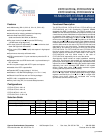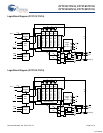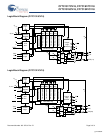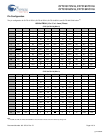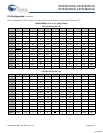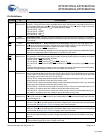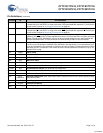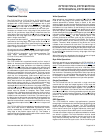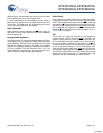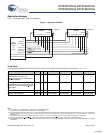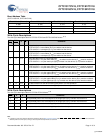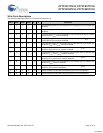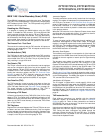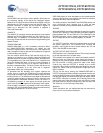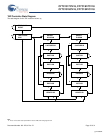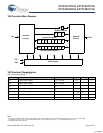
CY7C1317CV18, CY7C1917CV18
CY7C1319CV18, CY7C1321CV18
Document Number: 001-07161 Rev. *D Page 8 of 31
Functional Overview
The CY7C1317CV18, CY7C1917CV18, CY7C1319CV18, and
CY7C1321CV18 are synchronous pipelined Burst SRAMs
equipped with a DDR interface, which operates with a read
latency of one and half cycles when DOFF
pin is tied HIGH.
When DOFF
pin is set LOW or connected to V
SS
the device
behaves in DDR-I mode with a read latency of one clock cycle.
Accesses are initiated on the rising edge of the positive input
clock (K). All synchronous input timing is referenced from the
rising edge of the input clocks (K and K
) and all output timing is
referenced to the rising edge of the output clocks (C/C
, or K/K
when in single clock mode).
All synchronous data inputs (D
[x:0]
) pass through input registers
controlled by the rising edge of the input clocks (K and K
). All
synchronous data outputs (Q
[x:0]
) pass through output registers
controlled by the rising edge of the output clocks (C/C
, or K/K
when in single-clock mode).
All synchronous control (R/W, LD, BWS
[0:X]
) inputs pass through
input registers controlled by the rising edge of the input clock (K).
CY7C1319CV18 is described in the following sections. The
same basic descriptions apply to CY7C1317CV18,
CY7C1917CV18, and CY7C1321CV18.
Read Operations
The CY7C1319CV18 is organized internally as four arrays of
256K x 18. Accesses are completed in a burst of four sequential
18-bit data words. Read operations are initiated by asserting
R/W
HIGH and LD LOW at the rising edge of the positive input
clock (K). The address presented to address inputs is stored in
the read address register and the least two significant bits of the
address are presented to the burst counter. The burst counter
increments the address in a linear fashion. Following the next K
clock rise, the corresponding 18-bit word of data from this
address location is driven onto Q
[17:0]
, using C as the output
timing reference. On the subsequent rising edge of C the next
18-bit data word from the address location generated by the
burst counter is driven onto Q
[17:0]
. This process continues until
all four 18-bit data words have been driven out onto Q
[17:0]
.
The
requested data is valid 0.45 ns from the rising edge of the output
clock (C or C
, or K and K when in single clock mode, for 200 MHz
and 250 MHz device). To maintain the internal logic, each read
access must be allowed to complete. Each Read access
consists of four 18-bit data words and takes two clock cycles to
complete. Therefore, Read accesses to the device can not be
initiated on two consecutive K clock rises. The internal logic of
the device ignores the second read request. Read accesses can
be initiated on every other K clock rise. Doing so pipelines the
data flow such that data is transferred out of the device on every
rising edge of the output clocks (C/C
or K/K when in single-clock
mode).
The CY7C1319CV18 first completes the pending read transac-
tions, when read access is deselected. Synchronous internal
circuitry automatically tri-states the output following the next
rising edge of the positive output clock (C). This enables a
seamless transition between devices without the insertion of wait
states in a depth expanded memory.
Write Operations
Write operations are initiated by asserting R/W
LOW and LD
LOW at the rising edge of the positive input clock (K). The
address presented to address inputs is stored in the write
address register and the least two significant bits of the address
are presented to the burst counter. The burst counter increments
the address in a linear fashion. On the following K clock rise the
data presented to D
[17:0]
is latched and stored into the 18-bit
write data register, provided BWS
[1:0]
are both asserted active.
On the subsequent rising edge of the negative input clock (K
) the
information presented to D
[17:0]
is also stored into the write data
register, provided BWS
[1:0]
are both asserted active. This
process continues for one more cycle until four 18-bit words (a
total of 72 bits) of data are stored in the SRAM. The 72 bits of
data are then written into the memory array at the specified
location. Therefore, Write accesses to the device can not be
initiated on two consecutive K clock rises. The internal logic of
the device ignores the second write request. Write accesses can
be initiated on every other rising edge of the positive input clock
(K). Doing so pipelines the data flow such that 18 bits of data can
be transferred into the device on every rising edge of the input
clocks (K and K
).
When Write access is deselected, the device ignores all inputs
after the pending write operations are completed.
Byte Write Operations
Byte write operations are supported by the CY7C1319CV18. A
write operation is initiated as described in the Write Operations
section. The bytes that are written are determined by BWS
0
and
BWS
1
, which are sampled with each set of 18-bit data words.
Asserting the appropriate Byte Write Select input during the data
portion of a write latches the data being presented and writes it
into the device. Deasserting the Byte Write Select input during
the data portion of a write enables the data stored in the device
for that byte to remain unaltered. This feature can be used to
simplify read/modify/write operations to a byte write operation.
Single Clock Mode
The CY7C1319CV18 can be used with a single clock that
controls both the input and output registers. In this mode the
device recognizes only a single pair of input clocks (K and K
) that
control both the input and output registers. This operation is
identical to the operation if the device had zero skew between
the K/K
and C/C clocks. All timing parameters remain the same
in this mode. To use this mode of operation, tie C and C
HIGH at
power on. This function is a strap option and not alterable during
device operation.
DDR Operation
The CY7C1319CV18 enables high-performance operation
through high clock frequencies (achieved through pipelining) and
double data rate mode of operation. The CY7C1319CV18
requires a single No Operation (NOP) cycle when transitioning
from a read to a write cycle. At higher frequencies, some appli-
cations may require a second NOP cycle to avoid contention.
If a read occurs after a write cycle, address and data for the write
are stored in registers. The write information must be stored
because the SRAM cannot perform the last word write to the
array without conflicting with the read. The data stays in this
register until the next write cycle occurs. On the first write cycle
[+] Feedback



